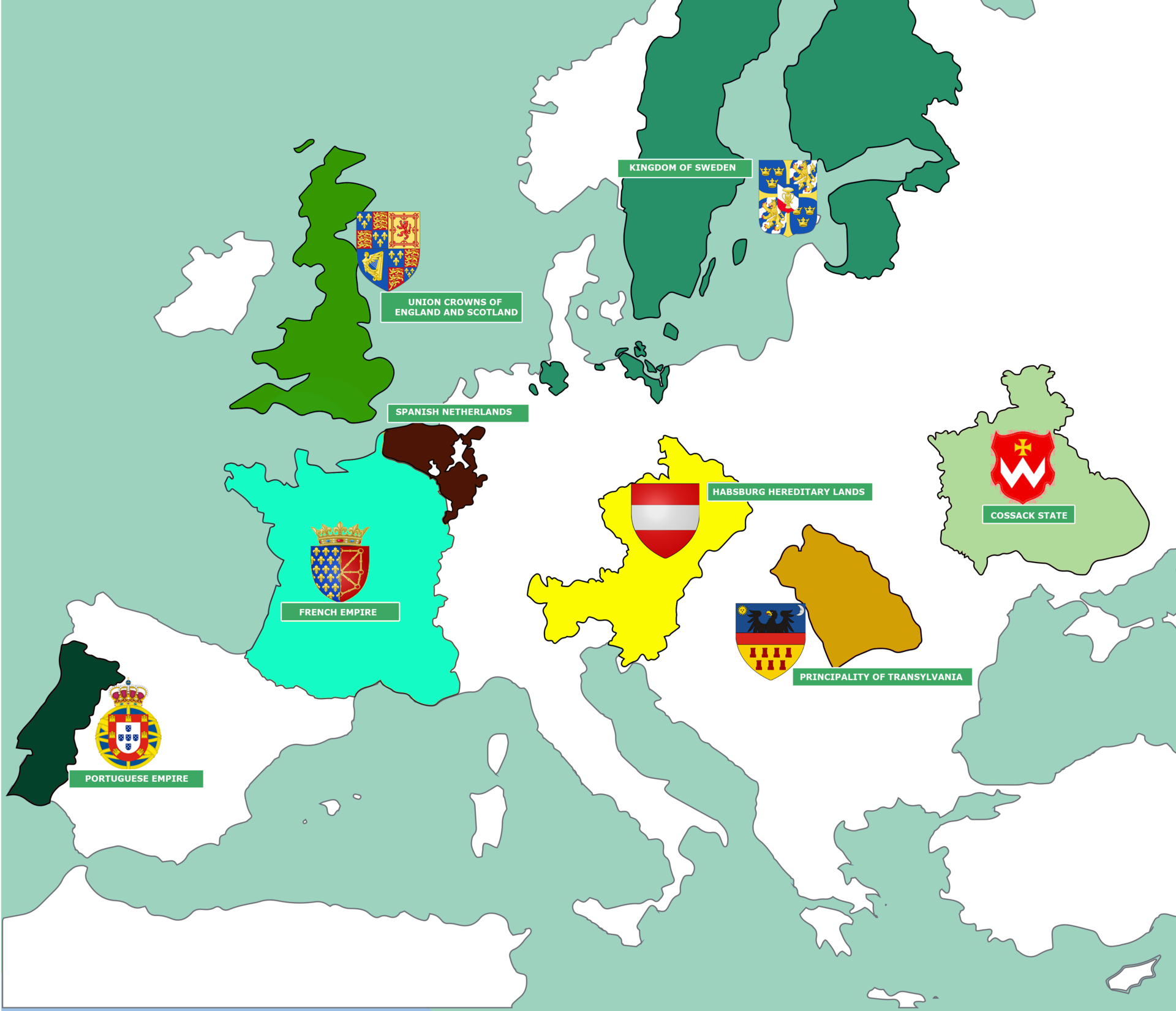The European Championship 1648
In Central Europe, the religious Thirty Years' War ended; France found itself under the ambitious cardinal Mazarin and continued the war against Spain, from which Portugal had previously seceded; England and Scotland were occupied with a civil war; Sweden became the most powerful military force in Northern Europe; the Apennine Peninsula consisted of mutually hostile petty states and city-states; the Netherlands became a power at sea; the Russian Empire expanded towards the east; Venice was at war with the Ottoman Empire in the Mediterranean; life in Southeast Europe took place within the Ottoman millet...
The year 1648 marked the ending of the religious Thirty Years’ War (1618 – 1648) that had engulfed Central and Western Europe. At first it was a civil war between opposing religious fractions, the Protestants and the Catholics, within the Holy Roman Empire, but it soon grew into the struggle for supreme power in Europe which, in particular phases of the war, included Denmark, Sweden, and the Catholic France. In the end, the Peace of Westphalia confirmed the freedom of religion within the Empire. The severity of the war led to the founding of strong animosities between the German-speaking regions of the Empire, which prevented any political unity up until the second half of the 19th century. Although this destroyed their ambitions for uniting all states of the Empire, the Habsburgs were not doomed to disappear, but were recognized by European powers, not only for their imperial title, but for their own power as well. Also, the Peace of Westphalia brought forth the system founded on the territorial sovereignty of an empire or kingdom, from which the collective affiliation of a nation would start to be determined according to the territory they inhabit.The remaining direct or indirect consequences of the war were that Sweden became a leading power in the Baltics, the Habsburgs recognized the independence of the Swiss Confederacy as well as the rebellious northern Protestant provinces, i.e. the Netherlands, which was already a power at sea. Furthermore, Portugal managed to secede from the Habsburg rule in Madrid, whose ruler not only had to contend with rebellions in Naples and Barcelona, but also with the continuing war against France, which would end only ten years after the Peace of Westphalia. France, on the other hand, was ruled by Cardinal Mazarin instead of the underage king Louis XIV, and from the beginning of the 17th century France instituted its hegemony over a great part of Western Europe. At the same time, isolated from the affairs on the mainland, England was shaken by a civil war between the king and the Parliament, which was directly connected to religious conflicts in Scotland, and the Catholic rebellion of the Irish against English rule.
Although it managed to preserve power in Southern and Central Europe, after the victory of the Reformation in the north, the Catholic Church started losing its monopoly over the truth and their ability of physically enforcing it. The Reformation and religious wars had their influence in partitioning Europe into the North and South, and their differences in interpreting and executing Christian teachings also had a role in the change of the political, economic, and social aspects of Europe. The continuous wars also had some incidental useful effects: innovations in military technology or the ability to more effectively collect funds for the needs of the military. Simply put, Europe consisted of hundreds of states and city-states, and as such was full of competing interests in the fields of politics, economy, literature, and science, and competition represents the driving force of innovation.
Hundreds of competing states, from kingdoms on the Western shores to numerous city-states that lay between the Baltics and the Adriatic, and especially England, the Netherlands, and France, could not stand aside while their enemies, i.e. Spain and Portugal, amassed wealth overseas. The Dutch and British governments granted trade monopoly to corporations in return for a share of their profits, and the agreement that those corporations would act as their naval partners against their adversaries. Although they had swelled the royal revenues, they reduced royal prerogatives, creating new and lasting operators in early modern states: bankers, stock holders, and company directors. The colonies represented safe export markets, which opposing sides could not protect with import taxes. This also meant larger returns on investments than they would have in their homelands.

Sources
- Niall FERGUSON, Civilizacija: Zapad i ostali, Zagreb, 2012.
- Grupa autora,''Tridesetogodišnji rat'': Velika ilustrirana enciklopedija, Zagreb, 2009.
- Vjeran KATUNARIĆ, Sporna zajednica : novije teorije o naciji i nacionalizmu, Zagreb 2003.
- Jacques LE GOFF, Stara i naša Europa, Zagreb, 2014.
- Alan John Percivale TAYLOR, Habsburška monarhija: 1809-1918., Zagreb, 1990.
- Patrick J. Geary, '' Postavljanje temelja ujedinjenog nemačkog identiteta'', http://www.danas.rs/danasrs/feljton/postavljanje_temelja_ujedinjenog_nemackog_identiteta.24.html?news_id=98844
- Map: http://hillfighter.deviantart.com/art/Europe-1648-190095688; http://www.conflicts.rem33.com/images/Ukraine/Kozac_E.htm;
- https://www.reddit.com/r/MapPorn/comments/193uhu/holy_roman_empire_in_1648_3000x2378/;
- http://geacron.com/home-en/?&sid=GeaCron270726;
- https://en.wikipedia.org/wiki/Swedish_Empire
- Photography: https://unsplash.com/photos/p4lgsiyGW0s
